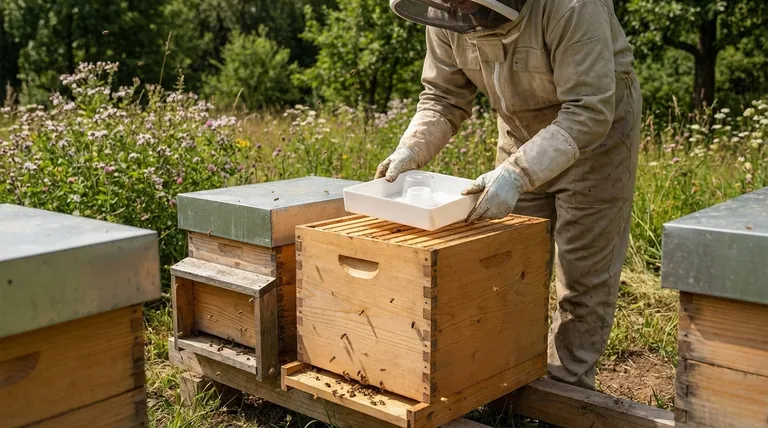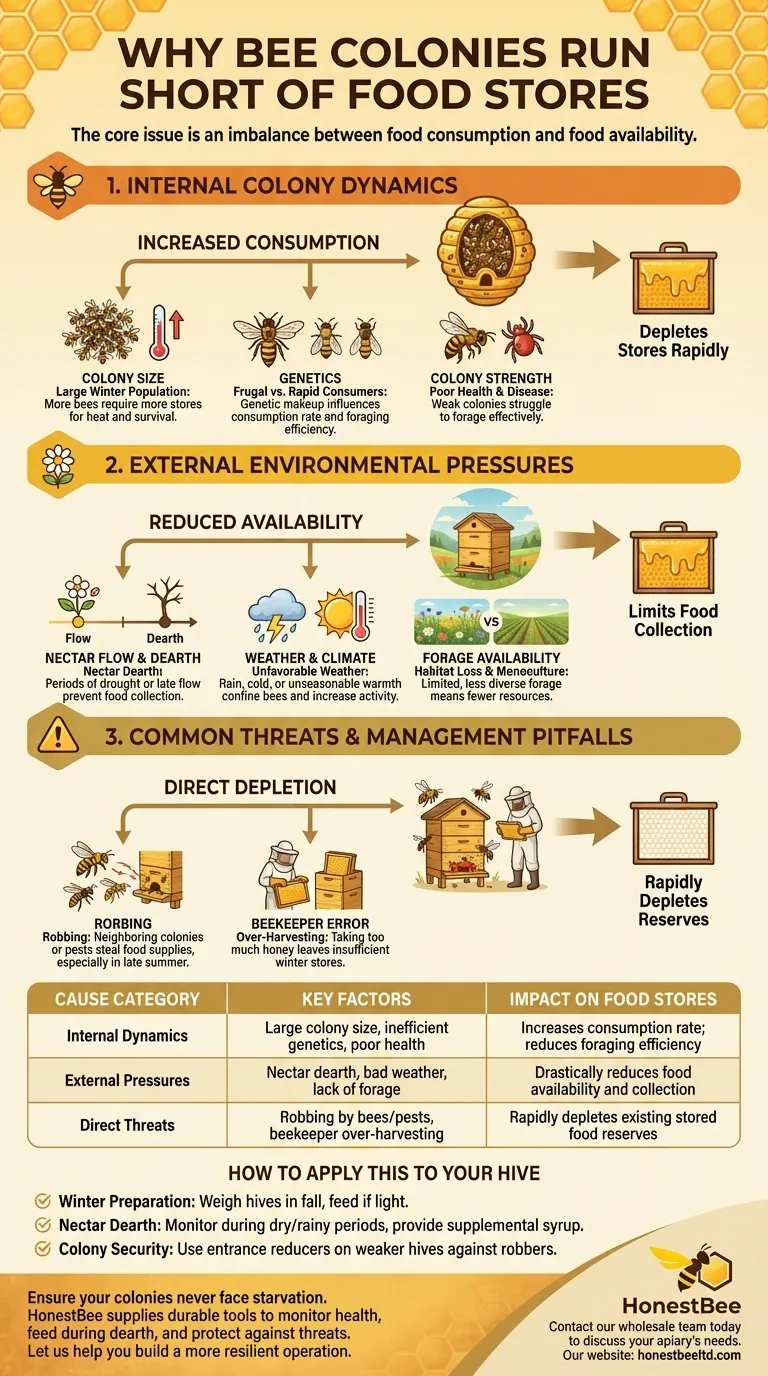A bee colony can run short of food for three primary reasons: internal colony dynamics, external environmental pressures, and direct threats like robbing. Factors like a large winter population consuming stores too quickly, a sudden stop in the nectar flow due to drought, or pests stealing honey can all lead to starvation.
The core issue is an imbalance between food consumption and food availability. A healthy, productive hive can still face starvation if its consumption rate outpaces what it can gather and store, a situation often triggered by a combination of factors both inside and outside the hive.

Internal Colony Dynamics
The state of the colony itself is a primary driver of how quickly it consumes its resources. A beekeeper must understand these internal factors to properly manage food stores.
Colony Size and Consumption Rate
A very large and populous colony is excellent for honey production during a strong nectar flow. However, that same large population becomes a liability when forage is scarce, especially during winter.
More bees require more honey and pollen to generate heat and survive. A winter cluster that is too large can burn through its winter stores long before the first spring flowers bloom.
Genetics and Foraging Efficiency
The genetic makeup of a queen and her offspring significantly influences the colony's behavior. Some genetic lines are predisposed to be more frugal with their stores, while others consume them rapidly.
Likewise, some bees are simply more efficient and aggressive foragers. A colony with poor genetics may struggle to collect sufficient resources even when they are available.
Overall Colony Strength
Colony strength isn't just about numbers; it's about health. A hive suffering from disease or high mite loads will be less effective at foraging.
Sick bees are poor workers, and a struggling colony may not have the population of healthy, prime-age foragers needed to bring in a surplus.
External Environmental Pressures
Bees are entirely dependent on their surrounding environment. Unfavorable conditions outside the hive are a major cause of food shortages.
The Nectar Flow and Dearth
The nectar flow is the period when flowers are producing abundant nectar for bees to collect. A colony's entire year revolves around capitalizing on this period.
If the spring nectar flow is late due to a cold, wet season, or if a summer dearth (a period with no nectar) is caused by drought, the bees cannot store the honey they need.
Weather and Climate
Unpredictable weather is a constant threat. A week of heavy rain can keep bees confined to the hive, forcing them to consume their stores instead of adding to them.
Similarly, an unseasonably warm spell in winter can cause the colony to become more active and consume more food than they would in a consistently cold state.
Forage Availability
The landscape surrounding the hive is its pantry. Habitat loss, monoculture farming, and the removal of flowering weeds and trees can drastically reduce the amount and variety of available pollen and nectar.
A lack of diverse forage means the colony may miss out on key nutrients or have a much shorter window in which to gather resources.
Common Threats and Management Pitfalls
Beyond natural causes, direct threats and beekeeper error can quickly deplete a colony's food reserves. It's critical to identify and mitigate these risks.
The Threat of Robbing
A weak hive's honey stores are a tempting target for stronger neighboring colonies, wasps, or other pests.
Once robbing begins, a struggling colony can have its entire food supply stolen in a matter of days. This is most common in the late summer and early autumn when nectar is scarce.
The Beekeeper's Role (Over-Harvesting)
One of the most common but overlooked causes of starvation in managed hives is beekeeper error. Harvesting too much honey, especially late in the season, leaves the colony with insufficient stores to survive the winter.
A responsible beekeeper must accurately assess how much honey the bees need for themselves before taking any surplus.
How to Apply This to Your Hive
Understanding these causes is the first step toward preventing them. Your management strategy should adapt based on the specific challenges your colony faces.
- If your primary focus is winter preparation: Weigh your hive in the fall to ensure it has adequate stores, and be prepared to feed if it feels light for its size.
- If your primary focus is navigating a nectar dearth: Monitor your hives closely during dry or rainy periods and provide supplemental sugar syrup to prevent starvation.
- If your primary focus is colony security: Use entrance reducers on weaker hives, especially in the fall, to help them defend against robbers.
By viewing the hive as a dynamic system influenced by both internal and external forces, you can anticipate problems and ensure your bees have the resources they need to thrive.
Summary Table:
| Cause Category | Key Factors | Impact on Food Stores |
|---|---|---|
| Internal Dynamics | Large colony size, inefficient genetics, poor health | Increases consumption rate; reduces foraging efficiency |
| External Pressures | Nectar dearth, bad weather, lack of forage | Drastically reduces food availability and collection |
| Direct Threats | Robbing by other bees/pests, beekeeper over-harvesting | Rapidly depletes existing stored food reserves |
Ensure your colonies never face starvation. A consistent, reliable supply of high-quality beekeeping equipment is fundamental to effective hive management. At HONESTBEE, we supply commercial apiaries and beekeeping equipment distributors with the durable tools and supplies needed to monitor hive health, feed colonies during a dearth, and protect against threats. Let us help you build a more resilient operation.
Contact our wholesale team today to discuss your apiary's needs.
Visual Guide

Related Products
- HONESTBEE Professional Hive Top Bee Feeder Feeding Solution
- Professional Hive Front Entrance Bee Feeder
- HONESTBEE Entrance Bee Feeder Professional Hive Nutrition Solution for Beekeeping
- Professional Hive Top Bee Feeder for Beekeeping
- HONESTBEE Professional Entrance Bee Feeder Hive Nutrition Solution
People Also Ask
- Why is a top feeder essential for bees? Ensure Colony Health and Efficiency
- What is a top feeder for bees? Maximize Colony Health with Efficient Feeding
- What are the advantages of hive top feeders? Maximize Feeding Efficiency for Your Apiary
- How is the plywood floor fitted into the hive-top feeder? Ensure Longevity with a Floating Floor Design
- How do I keep bees from drowning in my top feeder? Ensure Safe Feeding for Your Hive



















